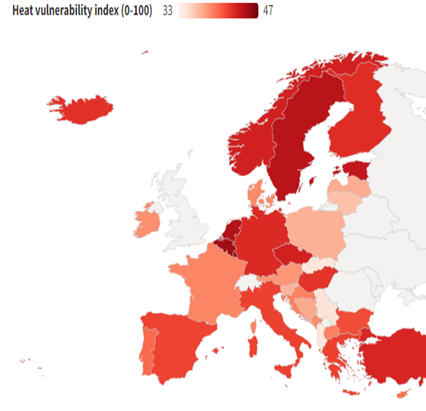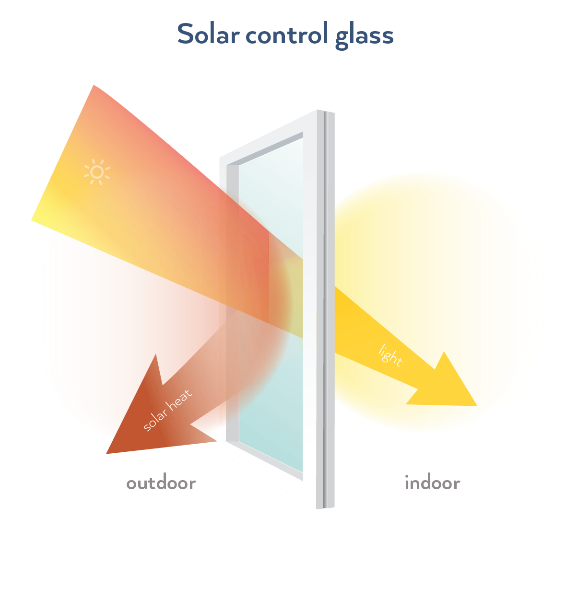 During the last years, heat waves have become more severe, frequent, and prolonged in the European Union and temperatures are expected to rise further in the next century throughout the continent.
During the last years, heat waves have become more severe, frequent, and prolonged in the European Union and temperatures are expected to rise further in the next century throughout the continent.
The impact of heat waves has shown that European buildings are not equipped to ensure safety and wellbeing to occupants during the hot season, aka “summer comfort”. While there is not a universal definition of summer comfort[1], this could be described as a satisfactory physical and mental state felt by people in a defined building in summertime.
The concept of summer comfort is undeniably linked to thermal comfort[2], but it is also related to the need to access natural daylight in daytime, be connected to the external environment, and access sufficient ventilation. An opening window equipped with a solar control glazing is key to these purposes.
Today’s glazing technologies can make EU buildings more resilient to future heat waves, enabling the adaption to climate change while helping to reduce energy needs and CO2 emissions.
Summer comfort: a social need

Ensuring summer comfort contributes to protect occupants’ health. The European population is becoming more and more vulnerable to heat waves[3] and buildings needs to adapt to limit the impact on wellbeing, but also on productivity.
During the last decades, the vulnerability to heat index[4] has increased throughout Europe for several factors such as an older population, rising chronic diseases and an increased unbanisation (see map).
Excessive indoor temperature in working spaces affects the performance of workers[5]. At the same time, workers without access to natural daylight reports poorer scores than their counterparts on quality-of-life measures related to physical problems and vitality[6].
Excessive sun radiation during the summer could cause overheating and consequent discomfort. To avoid that overheating management compromises the access to natural daylight, buildings should be
equipped with solutions which limit heat load while allowing sun light. Glazing technologies such as solar control glazing ensure summer comfort, access to daylight and external connection while helping to prevent overheating in summer period.
Summer comfort: an energy and climate commitment
Air-conditioning has become the main solution to keep indoor spaces comfortable when it is hot outside. Weather observations show that ‘the cooling degree days[7] value was almost three times higher in 2021 (100 degree days) than in 1979 (37), indicating that the need for cooling in a given building increased over the last decades[8]. Studies[9] forecast a high increase in the installation of cooling equipment in Europe’s buildings in the next decades, in both residential and tertiary segments.
Active solutions alone such as air-conditioning are not compatible with the EU decarbonisation objectives as they entail increased energy consumption. Passive cooling techniques like improved insulation, solar control and natural ventilation are the most successful at ensuring summer comfort while limiting energy demand and subsequent CO2 emissions.
Glazing’s contribution to moderate heat loads in buildings is important in the southern regions of Europe as well as in the rest of the continent. Energy consumption used to cool buildings could be reduced by over 27% all across Europe in 2050 by adequately using high-performance solar-control glazing.[10] The contribution of glazing to summer comfort and energy savings could be potentially higher thanks to novel glazing technologies available on the market.
Glazing technologies and summer comfortEnsuring summer comfort requires the integration of different cooling solutions and glass has a major role to play. In respect of the Energy Efficiency First principle, interventions in building aiming at increasing summer comfort should follow the steps below:
Only by reducing unwanted heat loads, EU buildings will ensure summer comfort and become more resilient to future heat waves and increased energy costs. Solar control glazing technologies help providing summer comfort, generate energy savings, and reduce CO2 emissions, while still ensuring light and views to the outside. Today, they are mainly used in commercial buildings and in southern regions, but their potential should be harnessed in colder climates as well as in the residential segment. Solar control coatings
When compared to other solutions (e.g., external shadings), solar control glass has negligible impact on the embodied carbon of the window or façade as it does not entail the manufacturing of additional components13. Dynamic glazing: switchable and electrochromic Thanks to its ability to adapt to solar heat and light depending on the weather conditions and comfort needs, dynamic glazing helps delivering summer comfort and allows significant reduction of cooling energy demand. When integrated into the automated control systems of buildings, these smart glazing solutions provide for a dynamic building envelope adapting to its environment. Different materials and systems are used to modulate thermo-optical properties of dynamic glazing such as chromogenic materials, liquid crystals and suspended particles. Shadings To further optimise the amount of solar heat gain entering a building, solar shadings can be combined with solar control glazing solutions. Shadings can be fixed or dynamic and can be equipped with energy production technologies. For example, solar shading integrating Building Integrated Photovoltaics (BIPV) can be used in facades and canopy to minimize the cooling loads and generate renewable energy. |
[1] The French Réglementation environnementale RE2020 defines “Summer comfort” as the level of discomfort felt by buildings occupants during the hot season. It includes a discomfort indicator which is calculated for the full year and set the thresholds at 26°C for the night and 28°C for the day. When the indoor temperature exceeds the comfort threshold, the discomfort indicator increases of an equal value.
[2] EN 16798-1:2019 gives guideline values that can be included in national regulations to guarantee that wellbeing and comfort of building occupants is taken into account in new and existing buildings.
[3] Heatwave events caused 77,000-129,000 deaths in the 32 EEA member countries between 1980 and 2020, representing 86%-91% of fatalities caused by climate-related extreme events. EEA, 2022. https://www.eea.europa.eu/publications/cooling-buildings-sustainably-in-europe
[4] The Heat Vulnerability Index calculates the vulnerability to heat. https://www.thelancet.com/journals/lanpub/article/PIIS2468-2667(22)00197-9/fulltext
[5] Productivity of workers can decrease by 30% during heat stress conditions. Occupational heat stress and economic burden: A review of global evidence, Borg et al. (2021)
[6] “Study links workplace daylight exposure to sleep, activity and quality of life”, American Academy of Sleep Medicine, 2013. http://tinyurl.com/ngqhj3z
[7] Cooling degree days are a measure of how much (in degrees), and for how long (in days), the outside air temperature was above a certain level. They are commonly used in calculations relating to the energy consumption required to cool buildings.
[8] EUROSTAT. https://ec.europa.eu/eurostat/web/products-eurostat-news/-/ddn-20220531-1
[9] “The Future of Cooling”, IEA, 2018.
[10] “Potential impact of high-performance glazing on energy and CO2 savings in Europe”, TNO, 2019.
[11] Sustainable Cooling Efforts – Exploring the Mitigation, Adaptation and Health Nexus, Ramboll,2022.
[12] Low-Emissivity, glass is a type of glazing glass containing a transparent coating that improves the thermal efficiency of windows.
[13] “Glass coatings present an effective way to reduce whole life carbon: they have an improved ‘return on investment’ when compared to external shading and internal blinds, due to their negligible impact on the embodied carbon (approximately 1 kgCO2e/m2), and relatively high positive impact on the operational carbon, reducing solar gains, heating requirements and need for artificial lighting. The optimal shading solution in terms of operational carbon will depend on the orientation of the building.” Carbon footprint of façades: significance of glass, ARUP, 2022.
Images
Map 1 – Source: https://www.cpc.ncep.noaa.gov/products/analysis_monitoring/regional_monitoring/europe.shtml
Map 2 – Source: https://climate-adapt.eea.europa.eu/en/metadata/indicators/vulnerability-to-extremes-of-heat

 Solar control glazing is a mature and affordable technology developed by the glass industry. The glass incorporates invisible coatings of special materials which have the dual effect of allowing daylight in, while radiating and reflecting away a large degree of the sun’s heat. The indoor space stays bright and much cooler than would be the case if uncoated glass were used. It can be combined with low-e glazing12 to ensure insulation in wintertime too.
Solar control glazing is a mature and affordable technology developed by the glass industry. The glass incorporates invisible coatings of special materials which have the dual effect of allowing daylight in, while radiating and reflecting away a large degree of the sun’s heat. The indoor space stays bright and much cooler than would be the case if uncoated glass were used. It can be combined with low-e glazing12 to ensure insulation in wintertime too.